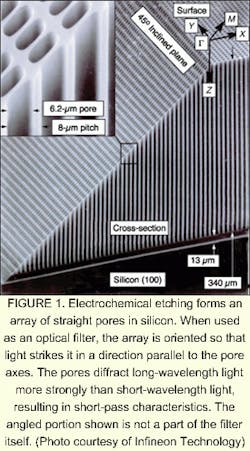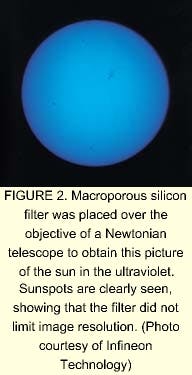Short-pass optical filters (filters that transmit short and reject long wavelengths) are an important part of many imaging systems. They can be used by themselves or in combination with narrowband filters to transmit isolated portions of the spectrum, often in the ultraviolet (UV). For example, in UV studies of the sun, short-pass filters can eliminate unwanted visible light. Such filters are normally made up of a multilayer thin-film coating on a glass substrate. But for short-enough cutoff wavelengths, the materials of the filter itself—both the substrate and the thin-film layers—limit the filter's transmittance.
One way around this problem would be to create a short-pass filter in which the sole transmissive medium is vacuum (or, in other cases, air). Researchers at Infineon (Munich, Germany), M. Theiss Hard- and Software, and Aachen University of Technology (both Aachen, Germany) have done just that. Beginning with the knowledge that a small aperture of large length in an absorbing medium can show short-pass characteristics, the researchers created a two-dimensional ordered array of deep, straight pores that pierce a slab of silicon (see Fig. 1). Each pore diffracts long-wavelength light so that the silicon absorbs it, while short-wavelength light passes straight through. The angular range of the macroporous filter is limited by the pores' aspect ratio.The pores are fabricated through an electrochemical process that forms dead-end pores; the remaining nonporous substrate is removed by alkaline etching, opening up the ends of the pores. Pore radii range from 0.15 to 10 µm, while their depths can reach 1 mm. The cutoff wavelength shifts toward the blue with decreasing pore diameter and increasing pore length. For short wavelengths, the filter transmission approaches unity when corrected for the fill ratio of the array. The array can be regarded as a grating, with the transmitted light being the undisturbed zero order. Thus, the filter itself does not limit the resolution of an imaging instrument containing the filter.
The researchers doped one sample of silicon—increasing its doping density by more than six orders of magnitude, to 1020 cm-3—in order to investigate whether higher conductivity would change the UV cutoff wavelength, says Volker Lehmann, one of the researchers. "No such effect was observed, which supports our model that the filter effect is caused by diffraction at the small apertures," he notes. An observed reduction in infrared transmission with increased doping was expected.
A 50-cm2 macroporous filter containing pores with a radius of 1 µm and a pitch of 3.5 µm was used in combination with a Newtonian telescope to obtain an image of the sun (see Fig. 2). The silicon in the filter was 75 µm thick, resulting in an acceptance angle of 1.5°. Corrected for fill ratio, the filter transmitted virtually all 200-nm light and virtually no 300-nm light. Changing the diameter and depth of the pores can vary the cutoff wavelength of these filters. The researchers expect that, as a result of silicon's mechanical properties, macroporous filters will work well even at high intensities, while their size will ultimately be limited only by the diameter of available silicon wafers.
About the Author
John Wallace
Senior Technical Editor (1998-2022)
John Wallace was with Laser Focus World for nearly 25 years, retiring in late June 2022. He obtained a bachelor's degree in mechanical engineering and physics at Rutgers University and a master's in optical engineering at the University of Rochester. Before becoming an editor, John worked as an engineer at RCA, Exxon, Eastman Kodak, and GCA Corporation.


